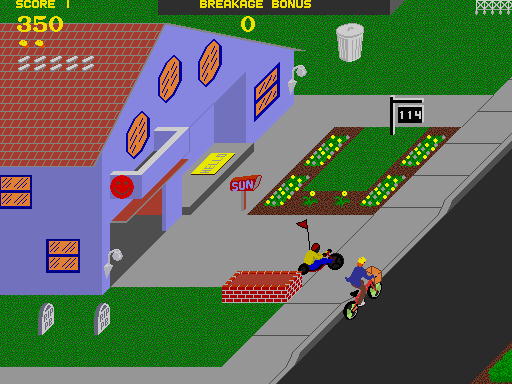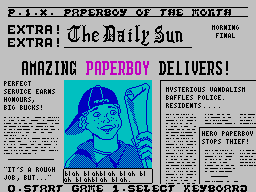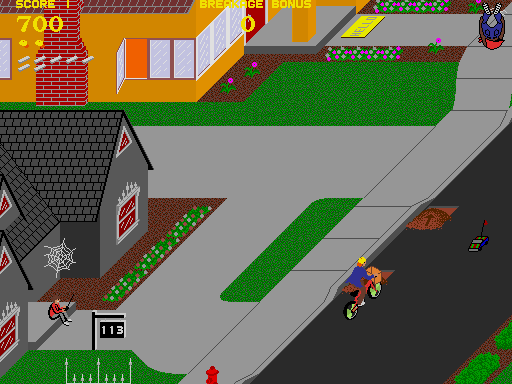Retro Replay Review
Gameplay
Paperboy’s gameplay is deceptively simple yet endlessly engaging. You assume the role of a suburban paperboy who must navigate a scrolling neighborhood street, tossing newspapers to designated houses while avoiding or even creatively inflicting damage on the homes of non-subscribers. The core mechanics revolve around timing your throws and steering your bike, which creates a satisfying balance of precision and speed. Each successful delivery adds to your score, while collisions and missed slots chip away at your limited lives.
(HEY YOU!! We hope you enjoy! We try not to run ads. So basically, this is a very expensive hobby running this site. Please consider joining us for updates, forums, and more. Network w/ us to make some cash or friends while retro gaming, and you can win some free retro games for posting. Okay, carry on 👍)
The game ramps up the challenge with a variety of dynamic obstacles. Construction workers emerge from behind barriers, skateboarders weave unpredictably across your path, and wayward tires bounce into the street at inconvenient moments. Dogs dash out of driveways and cats scuttle across the road, forcing split-second decisions. Even the occasional tornado or runaway car amps up the chaos, turning your Sunday route into a thrilling obstacle course.
What truly sets Paperboy apart is the reward for “creative chaos.” While your main goal is to deliver papers, the game explicitly encourages you to shatter windows and topple fences of non-customer houses. This dual objective adds a layer of strategic thinking: should you veer off course for bonus points, or stick to the straight path to ensure a perfect delivery streak? Combined with tight controls and escalating speed, every run feels like a fresh test of your reflexes and risk-reward instincts.
Graphics
For an arcade classic first released in the 1980s, Paperboy’s visuals remain charming and distinctive. The game uses vibrant, cartoon-style pixel art to bring the suburban landscape to life. Houses are color-coded to indicate whether you’re aiming for a delivery or a smash, and each prop—mailboxes, lampposts, and garden gnomes—is rendered with surprising clarity despite the hardware limitations of the era.
The sprites for pedestrians and obstacles are small but expressive. You can instantly recognize a construction worker’s bright orange vest or a cat’s arched back, which helps you plan your route a split second in advance. Parallax scrolling gives the lanes a sense of depth, and the smooth animation keeps the action flowing. When you smash a window or knock over a fence, the resulting pixelated shatter effects are both satisfying and hilarious.
Modern re-releases of Paperboy often include CRT filter options or optional upscaling, preserving the nostalgic look while smoothing out any rough edges. The color palette remains bold without being garish, and the consistent frame rate ensures that graphics never hinder the fast-paced action. Whether you play on original arcade hardware or a contemporary console, the visual style remains faithful and highly readable, making it easy to appreciate the game’s timeless aesthetic.
Story
Paperboy isn’t driven by a deep narrative, but it does offer a playful premise: you’re an entrepreneurial youngster determined to maintain your paper route while navigating suburban hazards. This lighthearted storyline provides just enough context to motivate your daily grind without bogging you down in cutscenes or dialogue trees. The game instead focuses on the pure thrill of the ride and the mischievous satisfaction of a well-aimed newspaper.
The suburban setting feels like a character in its own right. From the neatly trimmed lawns to the colorful row of houses, each neighborhood stage has its own personality. As you progress through the week—Monday to Saturday—the street layouts shift subtly, introducing new hazards and subscriber placements. Though the game never spells out a grand plot, the routine of earning household deliveries and dodging obstacles becomes its own compelling mini-story.
What story there is in Paperboy emerges through gameplay. A perfect week of deliveries and destructive detours feels like an accomplishment, and the end-of-week bonus screen rewards you with glowing messages from satisfied customers. Conversely, the occasional crash or missed paper can lead to comic indignation—complete with angry housewives and broken flowerpots. The narrative is less about character arcs and more about the evolving drama of your daily suburban adventure.
Overall Experience
Playing Paperboy today is like hopping on a time machine back to the golden age of arcade gaming. The pick-up-and-play nature makes it ideal for quick sessions, yet the depth of risk-reward decisions and obstacle memorization adds surprising replay value. Each run lasts only a few minutes, but chasing that perfect week and highest score can keep you hooked for hours.
The mix of exhilaration and humor is a huge part of its enduring appeal. Delivering papers by the bundle feels satisfying, but there’s real delight in veering off-course to smash a mailbox or topple a lawn gnome. Every collision, whether intentional or accidental, is accompanied by cartoonish sound effects that underscore the game’s playful spirit. This blend of skill-based challenge and cheeky antics feels fresh even decades after the original release.
For prospective buyers, Paperboy stands as a testament to arcade design that prioritizes clear objectives, responsive controls, and an addictive loop of action and reward. While it doesn’t offer branching narratives or cutting-edge visuals, its timeless gameplay and nostalgic charm make it a worthwhile addition to any retro or arcade compilation. If you’re looking for a title that combines quick thrills, memorable obstacles, and a dash of mischievous fun, Paperboy still delivers the goods.
 Retro Replay Retro Replay gaming reviews, news, emulation, geek stuff and more!
Retro Replay Retro Replay gaming reviews, news, emulation, geek stuff and more!









Reviews
There are no reviews yet.